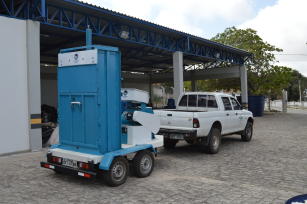Research aims to develop cotton picker for family farming
Research aims to develop cotton picker for family farming
Photo: Embrapa

Prototype of harvest unit adapted and connected to a tractor with tow to store the cotton
With the aim of making mechanized cotton harvest in small areas possible both in Brazil and in other countries in Latin America and the Caribbean, Embrapa Cotton, in partnership with the Food and Agriculture Organization of the United Nations (FAO), has been working on the development of a low-cost one-row cotton picker that can be connected to a tractor and replicated by smallholders. “The idea is to use simple technological resources that are of easy operation and adapted to the regional production context and the financial reality of such farmers”, Odilon asserts.
A major cotton producer until the 1980s, the Brazilian semiarid Northeast aims to revitalize the cultivation but faces a great obstacle: the cost of harvest. Nowadays the harvest is still manually performed in the region, and the cost of labor has rendered initiatives focused on expanding the crop impracticable. While in the Cerrados mechanized harvesting represents up to 5% of the total production cost, in the Semiarid region this cost leaps to about 60% of the production value.
“Manual harvesting limits the area that a smallholder is able to cultivate. They cannot manage to sow more than two hectares of cotton when they only use the manpower of the family itself. To broaden this area, it is necessary to hire third parties for labor. Therefore, cotton cropping is not attractive for smallholders and the main limiting factor is the cost of harvest”, explains the Embrapa researcher Odilon Reny Ribeiro.
In Brazil, there are no small-sized harvesters that could meet the demand from family farming. “Large manufacturers have not been investing in this type of equipment, as it is less lucrative due to its lower market value”, he states. “In other important cotton producing countries such as China, India, Pakistan and Uzbekistan, where few hectares are cultivated per farmer, equipment has been adapted for small areas. These are one- or two-row pickers”, he adds.
The researcher believes that Brazil can also reasonably expand production if mechanical harvesting is made feasible for family farming. “Uzbekistan today is one of the largest cotton producers of the world, even though it is cultivated by smallholders, because it managed to mechanize their harvests”, he observes.
Adapted one-row cotton picker
The cotton picker will be an adaptation of machines that have fallen into disuse in the Cerrados (photo below), as they have been recently replaced by more innovative equipment, which produces round bales in the machine itself. “Each of these disused machines has four to five harvest units (spindles) that could be used to fabricate four to five new one-row cotton pickers for family farming”, Odilon reccounts.
The machine will be adapted to a chassis and connected to the side of a tractor, harvesting a single row of cotton. Each one-row machine can harvest an area of up to 120 hectares per crop season (0.3 ha/hour). The equipment is expected to provide a reduction in the cost of harvest of up to 70% in comparison with manual harvest.
According to the researcher, importing small cotton pickers that are already developed in other countries would cost three times the price of a nationally fabricated adapted cotton picker. “The main reason is that the availability of low-cost harvest units (in the Cerrados) only occurrs in Brazil and this detail makes possible the obtention of machines at lower costs possible. Moreover, imported machines need maintenance and expensive spare parts that can be more difficult or more expensive than the equipment that has been traditionally used in the country”, he justifies.
The prototype (image above) will be tested this crop year and should be available to farmers within two years, at an estimated cost of R$ 80,000 to R$ 100,000. The technology has the potential to be adopted by cooperatives and associations of small-scale cotton growers in all of Brazil and in other countries, following the example of the mini mobile cotton gin, also developed by Embrapa to benefit small-scale colored, white and organic cotton farmers.
Translation: Mariana Medeiros
Edna Santos (MTB-CE 01700)
Embrapa Cotton
Press inquiries
algodao.imprensa@embrapa.br
Phone number: +55 83 3182-4361
Further information on the topic
Citizen Attention Service (SAC)
www.embrapa.br/contact-us/sac/

